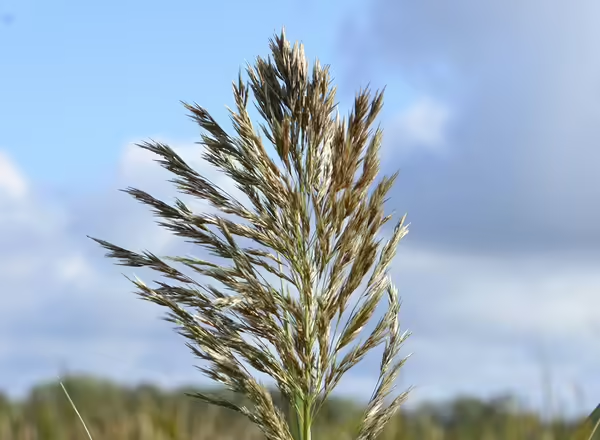
Invasive Phragmites
Phragmites Damage
Phragmites (Phragmites australis) is a warm-season grass that spreads aggressively through wetlands. Phragmites crowds out native wetlands species, forming dense monocultures. It can affect the hydrology of wetland communities and even impact aquatic life due to dense shading.
History of Phragmites
Phragmites has an interesting history. There is a subspecies of the grass that is native to the U.S.; however, a European subspecies was introduced in the 1800s and is believed to have replaced the native subspecies to a great extent.
Regulation of Phragmites
Phragmites is not listed as an invasive species in Illinois; however, it is in at least 16 other states.

Phragmites is a robust grass growing up to 16 feet tall. It has thick stems and leaves that can be 2 inches broad and 2-feet long. They tend to be held upright and form a 45-degree angle with the stem. You can sometimes find an M-shaped crimp along them. Phragmites has a hairy ligule. The inflorescence is a panicle that is more than 1 foot tall, heavily branched, and packed with spikelets, giving it a bushy appearance. Spikelets are elongated and often purple in color, turning brown. When mature, the seeds produce a puff of brown hairs.
Phragmites is extremely difficult to remove, due to its ability to vegetatively propagate from even the smallest fragment of plant material left behind.
- Mechanical removal: Not recommended. Mowing without chemical treatment will increase the infestation.
- Burning: Not recommended. Burning without chemical treatment will increase the infestation.
- Chemical control: Optimal treatment time is in the fall during flowering. Plants may be mowed to the ground or burned six weeks before chemical treatment and allowed to regrow until 24 inches or more in height to make application easier. Because Phragmites grows in and around waterways, precautions must be taken, and a National Pollutant Discharge Elimination System permit may be needed if herbicide may contact water. Apply 1 to 1.5% v/v aquatic safe glyphosate in water (up to 6 pints per acre). Alternatively, 1 to 1.5% solution of aquatic safe imazapyr, such as Habitat (up to 6 pints per acre) can be used for a more effective yet more costly treatment than glyphosate. Imazapyr and glyphosate may be combined 1:1 and mixed with water to make a 1 to 1.5% solution (3 pints glyphosate, 3 pints imazapyr per acre). Always read and follow the herbicide label before initiating treatment.
More resources
The Phragmites Adaptive Management Framework, by the Great Lakes Phragmites Collaborative